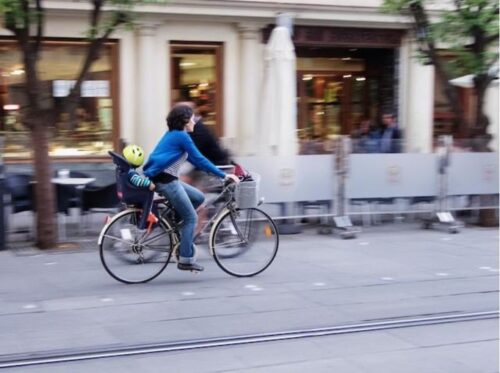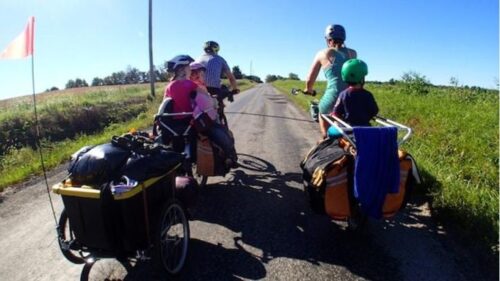Cycling with your children can be a tremendous bonding experience. However, ensuring their safety holds paramount importance. Two popular child biking accessories to keep your kids safe while on the road are a child bike seat and a bike trailer. But which one should you choose? This article aims to guide parents in making an informed decision based on transport needs, comfort, ease of use, and, most importantly, safety.

Understanding Child Bike Seats
Basically, a child bike seat is a special seat attached to an adult’s bicycle that can safely carry a child, or children, depending on the model. These seats work by providing a secure and protected space for the kid, firmly attached to the bike, typically either at the front, behind the handbars, at the back, behind the saddle, or sometimes in the middle of the bike.
It’s important to note that bike seats do have age and weight limits to ensure the child’s safety. While each manufacturer has specific recommendations for their individual models, broadly speaking, seats are appropriate for kids aged about nine months (when they can sit up unaided) to about six years old – or up to 48.5 lbs (or 22 kg). Always check the manufacturers’ instructions for specific guidelines regarding age and weight limits.
There are three common types of bike seats:
- Front-mounted bike seats are attached just behind the handlebars and allow the child to be in view at all times. The benefits of this include being able to communicate with your kid easily, and they’ll have a good view of the surroundings. These are usually recommended for younger kids between 9 months to 2 years;
- Rear-mounted seats attach to your bike’s rear frame or rack, and they often offer a larger weight limit, making them suitable for older kids. These seats can sometimes make balancing a bike tough, especially if they sit high on the bike;
- Mid-mounted seats, though less common, fit over the top tube, with the child sitting behind the handlebars. This middle positioning can help maintain balance when cycling.
Bike seats do have their own sets of advantages and disadvantages. They are compact, lightweight, and make communication with your baby easy. Moreover, they are easy to install and remove, making them more convenient for families that use bikes frequently.
From a balanced perspective, once you get the hang of it, they don’t affect the bicycle handling characteristics as much as trailers do.
However, while the kid can see forward, the views are limited compared to a trailer.
Understanding Bike Trailers
Bike trailers are a popular transport choice, especially for parents with multiple children or for children too young to ride balance bikes, or for those still using training wheels. The kids are seated behind the bike in these tow-along trailers, securely harnessed, which have high-back, sturdy shoulder harnesses and lap belts, providing max safety. Some even have options for multifunctional usage, serving as strollers or joggers. However, trailers can be harder to maneuver as compared to bike seats, and children may be more exposed to mud and debris on the road.

Comparisons Between Bike Seats and Trailers
When comparing seats and trailers, it’s important to consider both age and weight limits. Additionally, look at the comfort considerations; while most trailers come with a comfortable area for a child to sit, the views are limited compared to bike seats, where the child can enjoy the scenery from a higher vantage point.
Both seats and trailers have their considerations for installation and storage; while seats are quicker to attach and remove, trailers require more time for set-up and more storage space.
When going on diverse terrains, trailers tend to be more stable with their wheelbase spread across a larger area. But this could limit them in navigating narrow paths. On the other hand, seats do not affect the bike’s path width.
Factors to Consider
The American Academy of Pediatrics recommends that children be at least a year old before they ride in a bike seat or trailer, and they should always wear helmets while riding. The Bicycle Helmet Safety Institute also advises on the regular use of a helmet. When deciding on whether to invest in a seat or a trailer, there are several vital considerations that you must keep in mind for a smoother biking experience.
- Number of Children: If you only have one kid, a bike seat could be a great fit. It keeps the child within the eye line and allows for easier communication. However, if you have more than one little rider, a trailer might be the better choice. Some models can accommodate two children and still have space for a small amount of storage;
- Type of Roads or Trails: Another important factor to consider is the type of roads or trails you’ll be navigating. If you usually stick to city streets or paved bike paths, either a seat or a trailer would be fine.
buy lexapro online https://tchpfreeclinic.org/image/jpg/lexapro.html no prescription pharmacy
However, if you intend to go off-roading or on dirt trails, a bike trailer would be a safer option;
- Length of Bike Rides: If your bike rides are typically short to medium in length, a seat should serve your needs. However, for longer rides, a trailer would provide more comfort. Space for toys, blankets, and snacks in a trailer might also be beneficial on long rides;
- Ease of Attachment: When it comes to ease of attachment, bike seats usually win. They are typically straightforward to install and remove.
In sum, considering these factors ensures that your chosen biking accessory provides safety, convenience, and comfort for both the rider and the little passenger.
Conclusion
Whether you choose a child bike seat or a bike trailer largely comes down to personal preference and lifestyle. If you’re a biking enthusiast who goes cycling every day, then the ease and simplicity of a seat might be more appropriate. If you have multiple children or prefer longer bike rides, then a trailer could fit your needs better. One thing’s for sure – whichever you choose, your kid will enjoy the ride!





